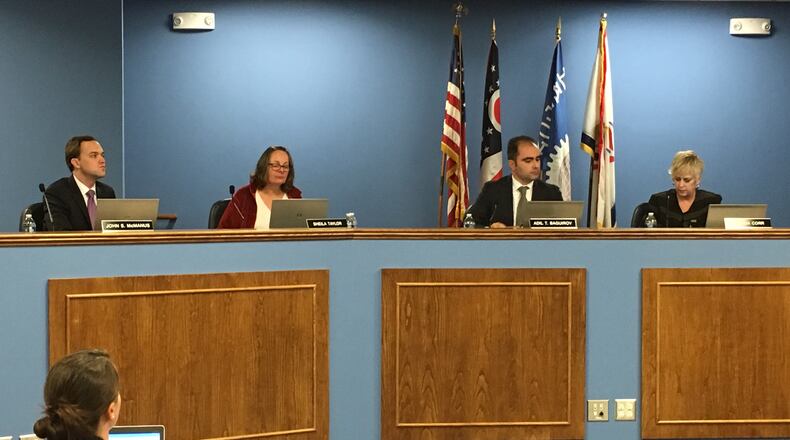“It comes out to something like $4.6 million,” Baguirov said, repeating a number he said a week earlier in talking about layoffs. “This is the real loss that we have incurred in one year.”
But school funding reports posted by the Ohio Department of Education late Tuesday show that DPS’ net funding for the year will drop $2 million, from roughly $107.7 million to $105.7 million as a result of lower enrollment.
ODE director of school funding Aaron Rausch confirmed those numbers for the Dayton Daily News. He said DPS is protected from a larger loss because it is a “capped funding district,” an issue district leaders are familiar with because it hurts them in other funding situations.
Dayton’s school board laid off 20 administrators last week on a recommendation from superintendent Rhonda Corr, who had consultants study district staffing. The board is slated to vote on about 30 more cuts at its 5 p.m. Thursday meeting, and has made dozens of other employees choose between layoffs or switching assignments.
DPS spokeswoman Jill Moberley confirmed through district treasurer Hiwot Abraha late Wednesday that the $2 million figure is correct. Moberley and Abraha said the driving force behind the personnel cuts is a desire to right-size the district staff because there are fewer students, not because of a particular dollar figure.
“The administration has always been very clear that the reduction of positions are due to a 10-year trend of declining enrollment,” Abraha said.
But Baguirov has repeatedly mentioned the financial angle to the cuts, talking about how charter school deductions “wreak havoc on our finances,” and how “lower receipts from the state force us to make some tough decisions sooner rather than later.”
The new enrollment data from ODE shows there are actually about 17 fewer Dayton students attending charter schools this year, but almost 300 more attending private schools on state vouchers.
Teachers union president David Romick said that in light of the new financial information, it probably wasn’t necessary for the school district to make such disruptive changes in the middle of a school year.
School board member John McManus, who has been critical of some of the cuts, agreed.
“It’s my firm opinion that this reduction in force moved far too quickly,” McManus said. “This process affects people’s lives and I feel that there should have been more time for employee and community input, as well as more study.
“The (financial) questions you’re asking give me even more reason to pause.”
Romick acknowledged that some staffing moves were needed because enrollment declines in some schools had left particular grades unbalanced, with too few students for the number of teachers. But the district’s changes went beyond that, creating “collateral damage” at other schools.
“So, $2 million is probably about 1 percent of the district’s budget,” Romick said. “That new figure could have perhaps made this a little less urgent, but hell, the horses are out of the barn now.”
Reached late Wednesday afternoon, Baguirov said he hadn’t seen the state funding report, although this newspaper sent a link to the report to all board members earlier in the day.
“All I’m going with is two simple numbers,” Baguirov said, referring to 577 students and $8,100 per student. “The data that you’re referring to has been released just now. We’ve been tackling this since late September and early October.”
ODE updates its funding each school year in November or December to switch from prior-year enrollment to current-year enrollment. Baguirov said early data more than a month ago had suggested the enrollment drop might be as high as 1,000 students, prompting the district to act quickly.
“The treasurer has been on the phone multiple times with the state officials. The number went down to 800, then stabilized at 577,” Baguirov said. “The (staffing) plan has been modified multiple times. … Originally, the number of (layoff) letters sent out was much higher than the number of people actually getting (laid off) now.
“Even with the paraprofessionals, the number probably will be much lower than the 30 (that district officials said Monday).”
Both Baguirov and district administrators have referred to a longer trend of sinking enrollment. Baguirov said the district has been losing a few hundred students per year. When told that state data shows DPS 2015-16 enrollment only 85 students lower than it was in 2010, he said, “that’s news to me.”
Abraha served as DPS’ assistant treasurer for 4½ years before taking over for ousted treasurer Craig Jones this summer. She said the district has a responsibility to ensure that staffing is in proportion to the number of students.
“We have made these decisions strategically and, in many cases, have seen teachers and support staff fill vacant positions, avoiding layoffs,” Abraha said. “While the process has been difficult, the success and well-being of our students are at the center of our decisions.”
Different approaches from board president, administration
"We have lost at least 577 students. If you multiply that by $8,100, which is the average compensation reimbursement that DPS gets from the state … it comes out to something like $4.6 million. This is the real loss that we have incurred in one year." — Adil Baguirov, president, Dayton Board of Education, talking about staff cuts
….
"This reduction of students is the driving force behind these (staff) changes. The administration has never maintained that it's a financial issue." — Hiwot Abraha, treasurer of Dayton Public Schools
About the Author

